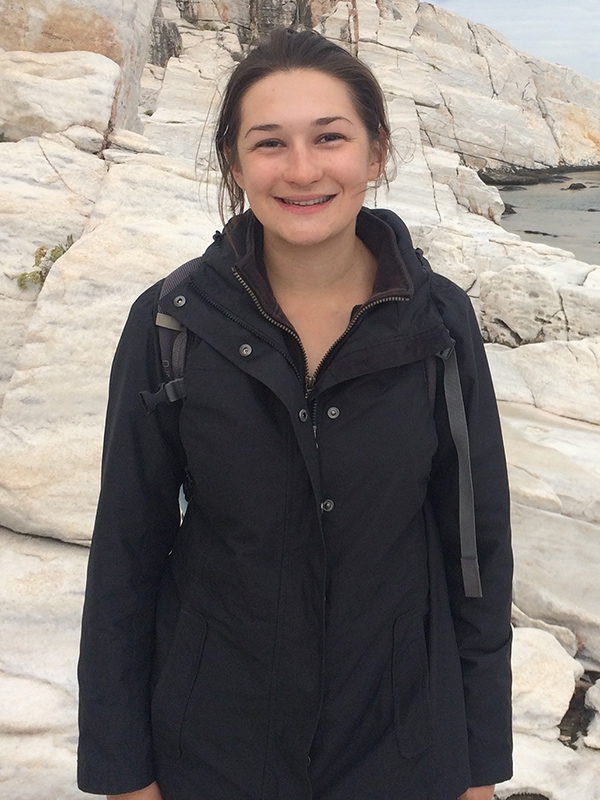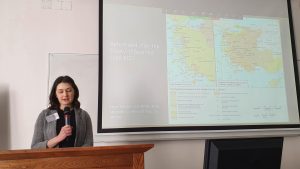
Christina DiFabio, Brown Üniversitesi’nde biyoloji, klasik çalışmalar ve klasik arkeoloji alanlarındaki eğitimini arkeoloji dalında üstün başarıyla tamamlayarak 2014’te lisans derecesini aldı. Hâlen Michigan Üniversitesi, Klasik Çağ Sanatı ve Arkeolojisi Programı’nda (IPCAA) doktora adayıdır. ANAMED’de üzerinde çalışacağı doktora tez projesinde M.Ö. yaklaşık 4. yüzyıl sonları ila M.S. 1. yüzyılda Batı Anadolu’daki şehir oluşumunu ve yerel toplulukların bu süreçteki rolünü inceleyecektir. Kentleşmedeki gelişmeleri incelemek için yerleşme örüntüsüne dair verileri kullanan DiFabio, bunların yanı sıra edebi, epigrafik ve ikonografik kaynaklar ile maddi kültür kaynaklarından elde edilen, siyasi ittifaklara, ticarete ve akrabalık bağlarına ilişkin kanıtlara da dayanarak yerel elitlerin kendilerini imparatorluk çapında veya şehirler arasındaki daha geniş ağlara eklemlemek amacıyla kentleşmeyi kullandığını savunuyor. DiFabio, Türkiye’deki Notion Arkeolojik Yüzey Araştırması ekibinin bir üyesidir. Yaptığı diğer saha çalışmalarında, Brown Üniversitesi’nin Labraunda Projesi’nde ekip üyesi (Türkiye), Vigla Arkeoloji Projesi’nde açma sorumlusu (Kıbrıs) ve Korinth’te açma eş-sorumlusu (Yunanistan) olarak görev yapmıştır.
Research Title: Synoikism and Urbanization: A Regional Approach in Hellenistic Anatolia
Ms. DiFabio obtained her BA in Biology, Classics, and Classical Archaeology from Brown University in 2014, with honors in archaeology. She is currently a PhD Candidate in the Interdepartmental Program in Classical Art and Archaeology (IPCAA) at University of Michigan. At ANAMED she is working on her dissertation project by examining city formation in western Anatolia from around the late fourth century BCE to the first century CE and the role of local communities in the process. By using settlement pattern data to examine urbanization developments as well as evidence for political alliances, trade, and kinship ties from literary, epigraphic, material culture, and iconographic sources, she argues that local elites used urbanization to insert themselves into larger imperial and inter-city networks. She is a team member of the Notion Archaeological Survey in Türkiye. Her other fieldwork consists of being a staff member with the Brown University Labraunda Project (Türkiye), a trench supervisor at the Vigla Archaeological Project (Cyprus), and a trench co-supervisor at Corinth (Greece).
Fellow’s End of Academic Year Research Report:
Synoikism and Urbanization: A Regional Approach in Hellenistic Anatolia
During the 2021–2022 academic year, I was fortunate to be a PhD Fellow at ANAMED to complete my dissertation, “Synoikism, Sympolity, and Urbanization: A Regional Approach in Hellenistic Anatolia,” chaired by Professor Christopher Ratté in the Interdepartmental Program in Classical Art and Archaeology at the University of Michigan. My research focuses on the Hellenistic period of Anatolia, ca. the late 4th century BCE to the 1st century BCE. After Alexander the Great’s death in 323 BCE, his conquered kingdom was divided among his generals and provincial governors. These successors eventually founded their own kingdoms, and continuous fighting among the successors defined the Hellenistic period as one of constant war and territorial changes, particularly in Anatolia. In the wake of these larger territorial changes, however, local communities were actively negotiating with each other and with the Hellenistic kings to form alliances and build upon urban growth.
In my dissertation, I use an interdisciplinary approach to examine these negotiations. I specifically examine the agency of local elites (namely, wealthy male individuals), as they were the ones who held political power at the local level and were most likely the ones making decisions for their larger communities. I examine their roles in two processes of urbanization: synoikism (when settlements combine to form a city) and sympolity (when two cities share a political system and may or may not move). Synoikism and sympolity have been major topics of historical research to examine Hellenistic urbanization, particularly with regards to the agendas of the Hellenistic kings. In my examination of these processes, I propose that local elite groups were major drivers of urbanization during this period.
An example of this local elite agency is described in a letter (preserved in an inscription) from King Eumenes II of the Attalid Kingdom of Pergamon right after 188 BCE to the city of Tyriaion in the ancient region of Phrygia.[i] The text discusses the synoikism of Tyriaion in which Eumenes II granted the community city status, but from the text, it is also apparent that the community directly appealed to Eumenes for this status, because the king acknowledges the messengers Tyriaion sent to him. The community of Tyriaion gained benefits from the king based on this formal recognition, including support for constructing a civic building (a gymnasium). This text is a great example of local elite agency in an urbanization process, but in the absence of such direct attestations, how can we consider the roles of communities? In my research, I propose a model with which to investigate local elite roles in urbanization through both archaeological and textual evidence.
I first use archaeological survey data to examine settlement patterns and how they changed before, during, and after the Hellenistic period. I then identify local elites’ presence and activities from funerary monuments, sanctuaries, trade, resource extraction, and textual testimonia. I examine this data for case studies in six ancient regions of western Anatolia (Ionia; Karia; Lycia; Kabalia; Pisidia; and Pergamon and its territory). Through this evidence, it is possible to trace how peer local elite groups interacted with one another before and during the urbanization processes.
Overall, I argue that local elites were building peer networks before urbanization through various modes of contact. Then, in response to external stimuli such as major political and environmental changes, I suggest that local elites were drawing upon this already-established peer network to build alliances and to form and/or renovate cities. These efforts, in turn, allowed them to gain access to new inter-city networks and to gain favor with the Hellenistic kings. For example, I have considered the presence of local elites in the region of Kabalia before the urbanization of the region through evidence of earlier funerary monuments. I suggest that rapid urbanization of the area occurred in response to the greater territorial change of the Treaty of Apamea in 188 BCE, which gave much of western Anatolia to the Attalid kingdom.
In case studies with textual evidence, I combine the textual and archaeological evidence to consider the agency of local elites in these processes. In case studies without textual evidence, I propose that local elites were relying on their peer network and appealing to the Hellenistic kings to urbanize. I suggest that local elites driving urbanization should be assumed in cases without direct textual evidence for the intervention of the Hellenistic kings. Moreover, analyzing the archaeological evidence for settlement occupation allows me to consider the impact of synoikism and sympolity on the broader communities, as it provides data for whether or not communities actually moved as a result of these processes. From the case studies, it is apparent that these processes could result in a range of outcomes (continued use of landscapes; “failed;” one city becoming the main partner) despite the intentions of promoting urbanization for greater status and recognition.
During my time at ANAMED, I spent the fall term writing my case study chapter on Pergamon and its territory and revising my case study chapter on Ionia. At the beginning of the spring term, I wrote my introduction and conclusion, and I revised my other chapters in preparation for my dissertation submission. I successfully defended my dissertation via Zoom on February 25, 2022, and I submitted the necessary revisions in March 2022 for University of Michigan’s graduation in late April 2022. I am very grateful for the feedback from my chair, Prof. Ratté, as well as my committee members at the University of Michigan: Sue Alcock, Ian Moyer, Lisa Nevett, and Nick Terrenato.
In addition to completing my dissertation, I presented my model and several case studies from my dissertation specifically in the context of local elite interactions at settlement borders for the postgraduate Perspectives of Classical Archaeology conference at Charles University, Prague: Border Zones—Meeting Places in the Ancient World on April 11, 2022 (Fig. 1). I was excited to take a new angle on my research to think about how local elite groups built their peer networks within border zones before formal alliances and about the motivations of different local elite groups during negotiations of changing borders within urban development.

Fig. 1. Christina presenting her paper at the Perspectives of Classical Archaeology conference at Charles University in Prague on April 11, 2022. (Photograph by Jana Mokrišová)
The time and support I received at ANAMED this past year were crucial for finishing my dissertation. The resources of the ANAMED library, as well as the DAI library in Istanbul, were very helpful during my final stages of research and writing. I also benefitted from the interdisciplinary academic environment at ANAMED, and I particularly enjoyed thinking about Anatolian urbanization diachronically with other fellows. The feedback I received during my In-House Presentation at ANAMED on January 5, 2022 was also very valuable, and I developed the key points of this presentation into the introduction of my dissertation. I especially appreciate feedback from Chris Roosevelt, Elif Koparal, and Christine Mikeska.
My time at ANAMED will continue to influence my work in the coming months and years, as I will now be spending my time developing an article based on one case study chapter from my dissertation and revising my dissertation into a book. In the next steps of my research, I will compare synoikism and sympolity in Anatolia to other regions of the eastern Mediterranean (such as Greece and Cyprus). I am also especially interested in considering the roles and experiences of marginalized groups that were affected by the decisions of the local elites. I sincerely thank ANAMED for its support during this fantastic year!
[i] Lloyd Jonnes and Marijana Ricl, “A New Royal Inscription from Phrygia Paroreios: Eumenes II Grants Tyriaion the Status of a Polis.” Epigraphica Anatolica 29 (1997): 1–29.

